When it comes to longevity, some animals can outlive us all! While humans can expect to live around 80 years, some animals can reach an impressive age of over 500 years. While we may never know the secrets to their long lives, it’s safe to say they’re living proof that living a long and healthy life is possible. Here are the 10 longest-living animals on Earth.
10- Elephants
Age: 70 Years

Elephants are the longest-living land animals on Earth, with lifespans that range from 50-70 years. These impressive creatures are renowned for their intelligence, strength, and social behavior. Elephants have a complex social structure, with matriarchal herds led by the oldest female. They communicate through a variety of vocalizations and use their trunk to touch and greet each other. They are incredibly loyal animals, often forming strong bonds that last for life.
Despite their large size and strength, elephants are herbivores and use their tusks to strip bark off trees to eat. They consume large amounts of vegetation and can travel up to 30 miles in search of food. Elephants have a great memory and can recognize family members and friends even after many years. They also have a strong sense of compassion, often helping other injured or distressed individuals. Elephants are a highly social species, and are capable of showing emotion and understanding complex relationships. As one of the longest living animals on the planet, elephants have a unique and fascinating lifestyle that is truly awe-inspiring.
9- Macaw
Age: 80 Years
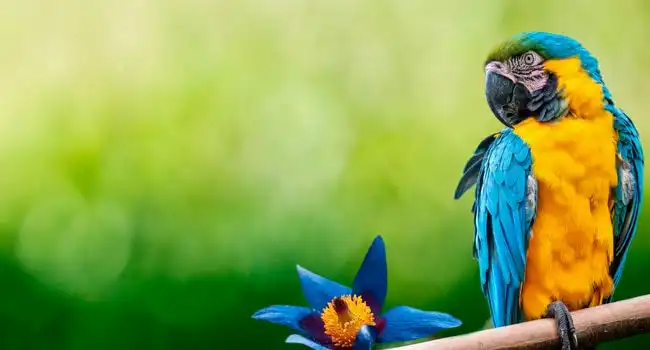
The macaw is one of the longest-living animal species. It can live up to an impressive 50-60 years in captivity, and up to 40 years in the wild. The macaw is a stunning and intelligent bird that has an array of vibrant colors. Its wingspan can reach up to 3-4 feet in length, making it one of the largest flying birds in the world. Its powerful beak allows it to crack open a wide variety of nuts and seeds, as well as hard-shelled fruits and vegetables.
Macaws are known for their loud vocalizations and for their ability to mimic human speech. They are highly social birds and form strong bonds with their owners, making them ideal pets. Macaws require a lot of attention and daily enrichment activities to keep them happy and healthy. They need large cages and plenty of space to move around and fly. With the right care and nutrition, macaws can live long, happy lives.
8- Galagapos Giant Tortoise
Age: 150 Years
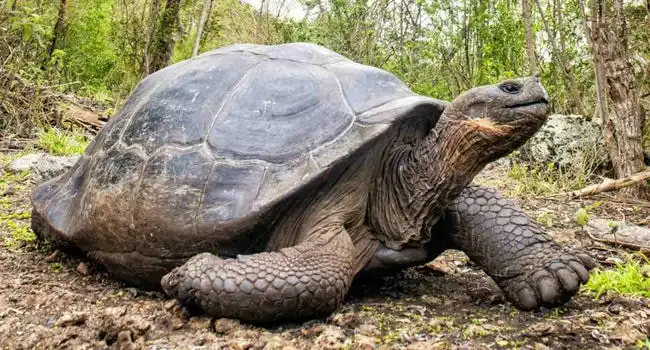
The Galapagos giant tortoise is one of the longest-living animals in the world. It can live up to a whopping 150 years, surviving in the wild for centuries. The tortoises have a slow metabolism, meaning they need less food and water than other animals. This allows them to survive in the harsh desert climate of the Galapagos islands. They have a tough and protective shell that helps to keep them safe from predators. The shells also provide insulation from the heat and cold that the islands experience.
They also have a remarkable ability to adapt to different environments and can even travel long distances over land. The Galapagos giant tortoise has been an integral part of the islands’ biodiversity for centuries, providing a unique insight into the history of the island. They are an iconic species and a symbol of the unique beauty and diversity of the Galapagos Islands.
7- Rougheye Rockfish
Age: 200 Years

The Rougheye rockfish is an incredible creature. It is one of the longest living animals in the world, with some specimens having been known to live for up to 205 years. This species of fish is found in the cold waters of the North Pacific, ranging from Northern Japan to the coasts of Alaska. They can reach an impressive length of up to three feet and can weigh up to twenty pounds.
Rougheye rockfish have a unique set of adaptations that allow them to live such long lives. They have a slow growth rate and a low metabolic rate, which helps them to conserve energy and extend their lives. They also have a strong immune system that helps them to fight off disease and infection. Additionally, they possess an impressive ability to survive in cold temperatures, which extends their lifespan even further.
6- Red Sea Urchin
Age: 200 Years

Red sea urchins are one of the longest living animals on the planet, boasting an impressive lifespan of up to 200 years. These spiny creatures are native to the shallow, temperate waters of the Red Sea, where they inhabit the rocky seafloor. Red sea urchins feed on algae and other decaying organic material, using their five sharp teeth to scrape the ocean floor. They have a hard external shell, called a test, which helps to protect them from predators.
The test is covered in spines that can be retracted when necessary. Red sea urchins reproduce by releasing eggs and sperm into the water, which then fertilize and develop into larvae. The larvae drift with the currents until they eventually settle on the seafloor and grow into adults. Red sea urchins can also regenerate damaged body parts, including their teeth and spines. This unique ability allows them to survive for such a long period of time.
5- Bowhead Whale
Age: 250 Years

Photo Credit: WWF
Bowhead whales are one of the longest-living animals on Earth. They are able to live for over 200 years. But bowhead whales can reach the age of 250 years or more. These whales have been known to migrate from the Arctic to the Antarctic in search of food. They are also able to dive over 2,000 feet deep in their search for food. Bowhead whales feed mainly on zooplankton, fish, and krill. The bowhead whale is an extremely intelligent creature that is able to use its environment to survive.
Its thick layer of blubber helps it to stay warm in the cold waters of the Arctic. Its powerful tail allows it to move quickly in the water and its long baleen allows it to filter out its food from the water. Bowhead whales are able to communicate with each other through a variety of sounds. These sounds can be heard from miles away. The bowhead whale is an amazing creature that has been able to survive for centuries and will continue to do so for many more.
4- Greenland Shark
Age: 400 Years
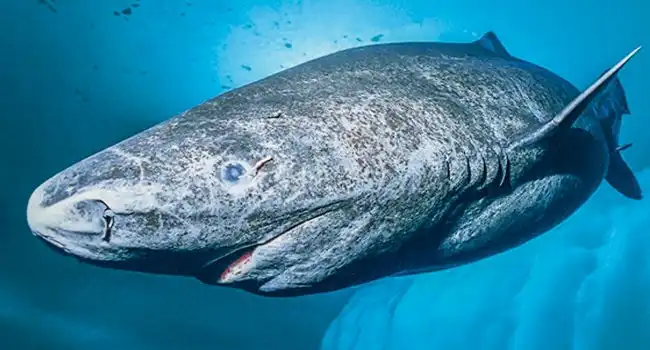
Photo Credit: LRB
The Greenland Shark is one of the longest living animals on the planet, with an estimated lifespan of up to 400 years. This remarkable species is found in the cold, deep waters of the North Atlantic, typically swimming at depths of between 600 and 1,200 meters. This species is a slow-moving predator, typically feeding on fish, squid, and marine mammals. It has a large and distinctive head, with a short and blunt snout, and large eyes.
Its body is a mottled gray color and can grow up to 8 meters long. The Greenland Shark is different from other sharks in that it does not have to constantly keep swimming to stay afloat. Instead, it uses its large, muscular pectoral fins to glide through the water. It is also capable of slowing down its metabolism in order to conserve energy during periods of low activity.
3- Ocean Quahog Clam
Age: 500 Years

The ocean quahog clam is one of the longest-living animals on Earth. It has an estimated lifespan of up to 500 years. The oldest living specimen was approximately 507 years old when it was found in 2006. Its shell is a deep brown color, and its flesh is white and firm. Its scientific name is Arctica islandica. The ocean quahog clam is an important species in the marine ecosystem, as it is a key food source for many other animals. It is also a keystone species, meaning it plays a critical role in its environment. It can be found in the North Atlantic and Arctic oceans, as well as in certain estuaries and bays.
The ocean quahog clam is a filter feeder, meaning it feeds by filtering plankton, bacteria, and other small particles out of the water. It is a hermaphroditic species, capable of both self-fertilization and cross-fertilization. The ocean quahog clam is a hardy species, able to survive and reproduce in a range of temperatures, salinities, and depths. Its tough shell helps protect it from predators, and its long lifespan makes it an ideal species for long-term studies of the ocean environment.
2- Hydra
Age: Immortal
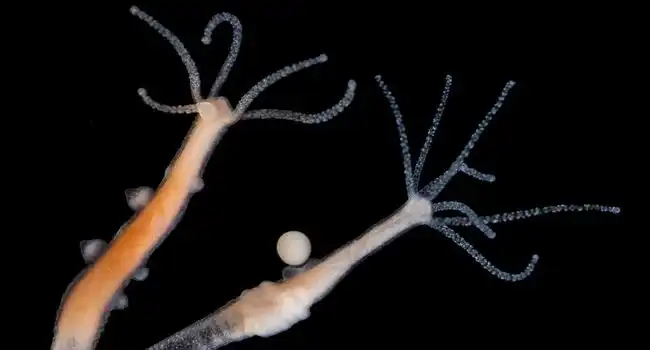
Photo Credit: UCdavis
The Hydra is one of the most fascinating and longest-living animals on the planet. It is a freshwater invertebrate, belonging to the phylum Cnidaria. Hydra has been around for millions of years. Despite their simple, tube-like body structure, these animals are surprisingly complex.
Hydra have a unique ability to regenerate and reproduce, meaning they can regrow parts of their body or reproduce asexually. They can also regenerate from just a single cell, making them incredibly resilient. They have a simple digestive system, consuming food like small fish, protozoans and other animals.
1- Turritopsis Dohrini
Age: Immortal
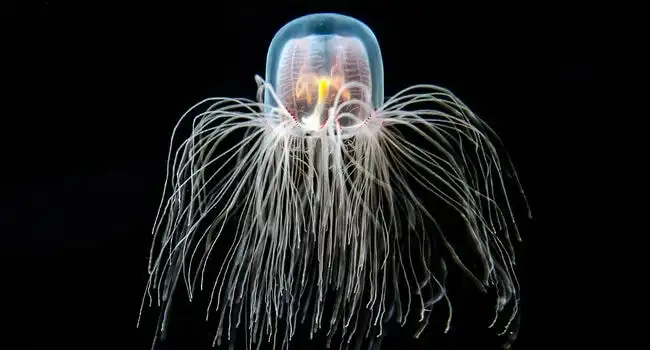
Turritopsis dohrini, commonly referred to as the immortal jellyfish, is the longest-living animal known to man. This tiny aquatic creature, which belongs to the Hydrozoa class, is capable of reverting back to its juvenile polyp state after reaching sexual maturity. This process, known as transdifferentiation, happens when the jellyfish is under extreme stress, such as starvation, injury, or disease.
The jellyfish then begins to develop back into the juvenile polyp form, which can then regenerate into a medusa, or adult jellyfish form. This process of rejuvenation can repeat itself indefinitely, allowing the jellyfish to live forever. This remarkable ability has enabled Turritopsis dohrini to become the only known animal capable of practically achieving immortality.


